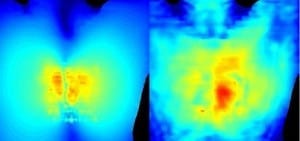The findings could dramatically alter the scale of medical devices implanted in the human body.
A team of engineers at Stanford has demonstrated the feasibility of a super-small, implantable cardiac device that gets its power not from batteries, but from radio waves transmitted from outside the body. The implanted device is contained in a cube just eight-tenths of a millimeter in radius. It could fit on the head of pin.
The findings were published in the journal Applied Physics Letters. In their paper, the researchers demonstrated wireless power transfer to a millimeter-sized device implanted five centimeters inside the chest on the surface of the heart—a depth once thought out of reach for wireless power transmission.
The paper’s senior author was Ada Poon, an assistant professor of electrical engineering at Stanford. Sanghoek Kim and John Ho, both doctoral candidates in Poon’s lab, were first authors.
The engineers say the research is a major step toward a day when all implants are driven wirelessly. Beyond the heart, they believe such devices might include swallowable endoscopes—so-called “pillcams” that travel the digestive tract—permanent pacemakers and precision brain stimulators. The devices could potentially be used for virtually any medical applications for which device size and power matter.
A REVOLUTION IN THE BODY
Implantable medical devices in the human body have revolutionized medicine. Hundreds of thousands if not millions of pacemakers, cochlear implants and drug pumps are today helping people live relatively normal lives, but these devices are not without engineering challenges.
First off, they require power, which means batteries, and batteries are bulky. In a device like a pacemaker, the battery alone accounts for as much as half the volume of the device it drives. Second, batteries have finite lives. New surgery is needed when they wane.
“Wireless power solves both challenges,” said Poon.
Last year, Poon made headlines when she demonstrated a wirelessly powered, self-propelled device capable of swimming through the bloodstream. To get there she needed to overturn some long-held assumptions about delivery of wireless power through the human body.
Her latest device works by a combination inductive and radiative transmission of power. Both are types of electromagnetic transfer in which a transmitter sends radio waves to a coil of wire inside the body. The radio waves produce an electrical current in the coil sufficient to operate a small device.
There is an indirect relationship between the frequency of the transmitted radio waves and the size of the receiving antenna. That is, to deliver a desired level of power, lower frequency waves require bigger coils. Higher frequency waves can work with smaller coils.
“For implantable medical devices, therefore, the goal is a high-frequency transmitter and a small receiver, but there is one big hurdle,” explained Kim.
IGNORING CONSENSUS
Existing mathematical models have held that high frequency radio waves do not penetrate far enough into human tissue, necessitating the use of low-frequency transmitters and large antennas—too large to be practical for implantable devices.
Poon proved the models wrong. Human tissues dissipate electric fields quickly, it is true, but radio waves can travel in a different way—as alternating waves of electric and magnetic fields. With the correct equations in hand, she discovered that high-frequency signals travel much deeper than anyone suspected.
via Stanford School of Engineering
The Latest Streaming News: Wirelessly powered medical device updated minute-by-minute
Bookmark this page and come back often
Latest NEWS
Latest VIDEO








